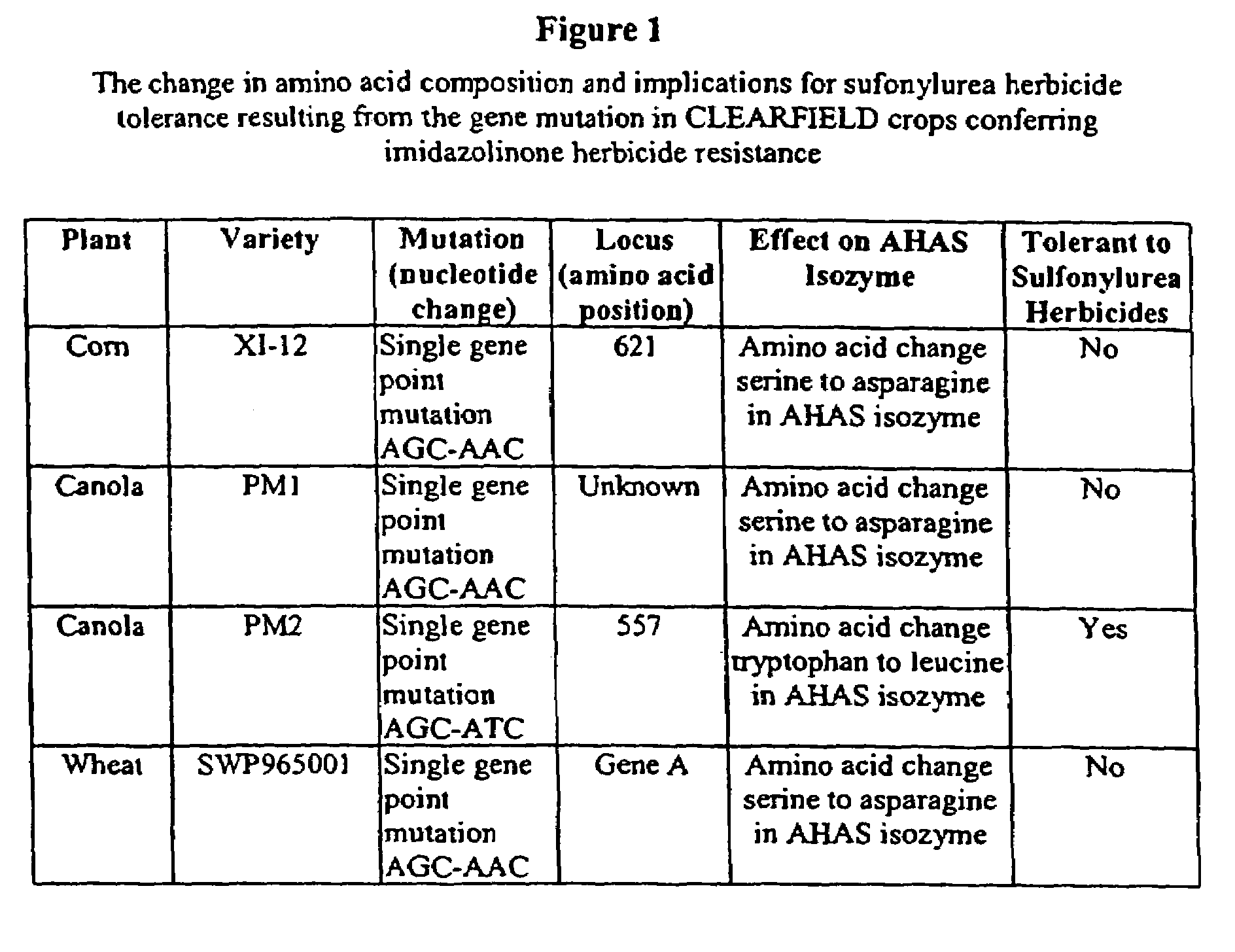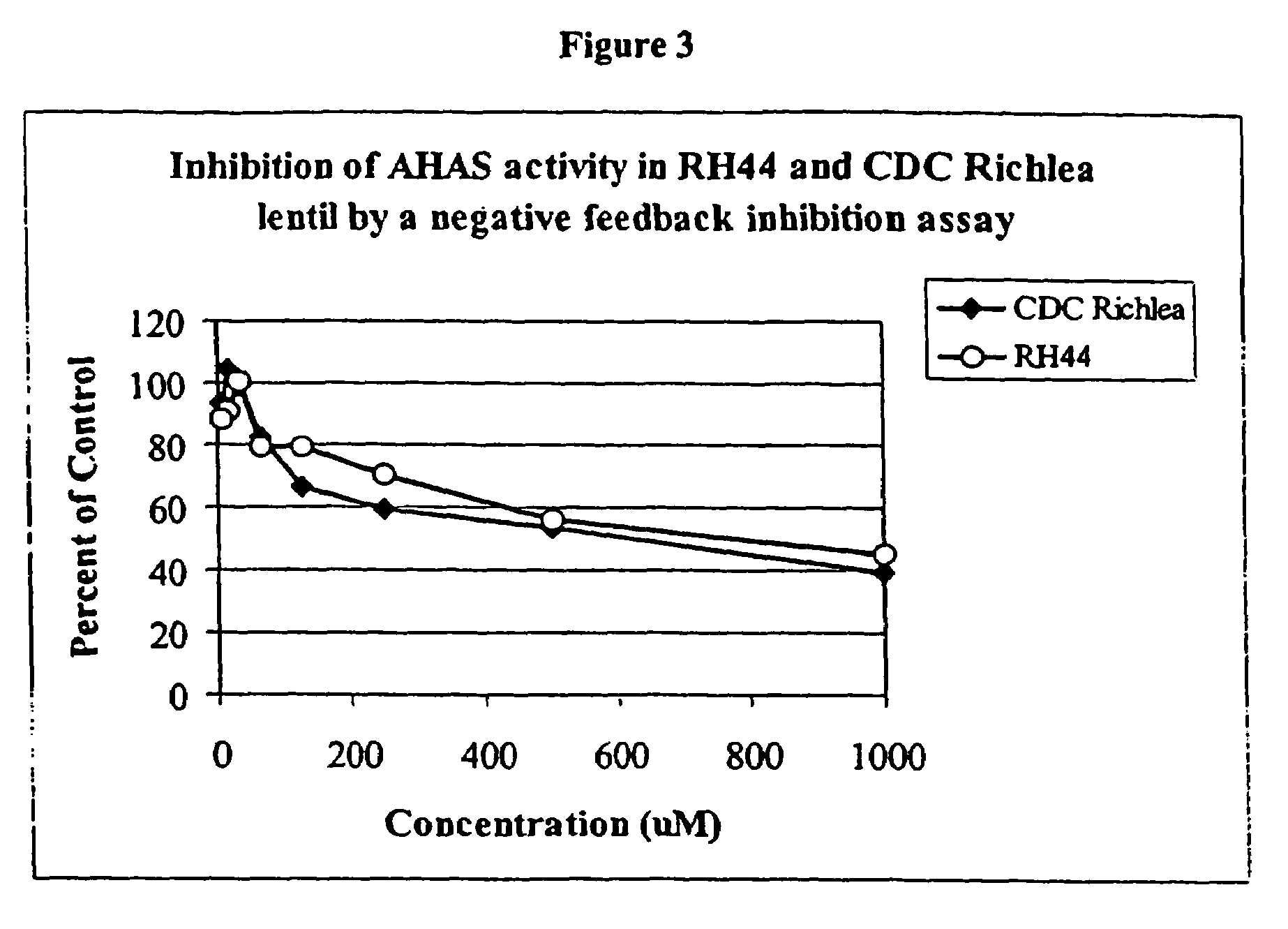Lentil plants having increased resistance to imidazolinone herbicides
a technology of herbicides and plants, applied in the field of plants having an increased resistance to imidazolinone herbicides, can solve the problems of poor competition, weed control in lentil production, and the inability to describe an imidazolinone resistant pulse crop, so as to and increase the resistance to an imidazolinone herbicide
- Summary
- Abstract
- Description
- Claims
- Application Information
AI Technical Summary
Benefits of technology
Problems solved by technology
Method used
Image
Examples
example 1
Mutagenesis of Mixed Lentil Seed and Selection of RH44 Lentil Variety Having Increased Resistance to Imidazolinone Herbicides,
[0039]Lentil line RH44 was derived from a bulk of mixed F3 lentil (Lens culinaris) seed developed via conventional crossing followed by self-pollination. Five kilograms of bulk, mixed seed were treated in EMS solution and then planted in the field as the M1 generation. M2 seeds were harvested from the field-grown M1 plants. M2 plants were advanced to the M3 generation. M3 seed was planted on 1 hectare (ha). Prior to flowering, the field was sprayed with 2×ODYSSEY® herbicide. At harvest, approximately 300 surviving plants were harvested and threshed. Approximately 150 plants were selected for further evaluation by planting a sample of seed from each plant in pots in growth rooms. These plants were sprayed with 2×ODYSSEY® herbicide at four weeks after emergence. Eight pots were selected for field evaluation. Seed of each line was sown in a small field plot and ...
example 2
Analysis of Mutation in Lentil Variety RH44
[0040]The available data strongly indicates that a mutation in a single gene similar to that observed in wheat, corn and canola is responsible for the observed imidazolinone tolerance in the RH44 variety of lentil. In wheat, the AHAS isozyrnes have been labeled as genes A, B and C. The mutation responsible for imidazolinone tolerance in wheat is due to a point mutation of AGC to AAC at a single site in AHAS gene A (FIG. 1). This site corresponds to the maize amino acid position 621 previously identified in X1–12 (imidazolinone-tolerant maize). This single nucleotide change of a guanine to an adenine results in a single amino acid change serine to asparagine (FIG. 1). Additionally, the imidazolinone tolerance trait in CLEARFIELD® canola is controlled by two semi-dominant genes PM1 and PM2. Resistance to the PM1 mutant is conferred through a guanine to adenine point mutation in the AHAS1 gene. This results in a similar single amino acid chang...
example 3
Herbicide Resistance of the RH44 Lentil Variety
[0042]The responses of the RH44 lentil variety and the CDC Richlea variety were identical in a negative feedback inhibition assay. As described earlier, AHAS is an enzyme active in the biosynthesis of leucine and valine. Under conditions of excess leucine and / or valine, the activity of AHAS is diminished. The ability of leucine and valine addition to inhibit AHAS activity was the same in the RH44 lentil and CDC Richlea lentil varieties, indicating very similar levels of expression and a lack of any discernible difference in AHAS function (FIG. 3).
[0043]The AHAS activity in the wild type CDC Richlea lentil variety was inhibited by imazapic (CADRE®)) (FIG. 4) and imazethapyr (PURSUIT®) (FIG. 5) representative of all imidazolinone herbicides. The AHAS activity in the RH44 lentil variety was also inhibited by the addition of the two imidazolinone herbicides, but not to the same extent as for the wild type lentil CDC Richlea.
[0044]These resu...
PUM
| Property | Measurement | Unit |
|---|---|---|
| height | aaaaa | aaaaa |
| resistance | aaaaa | aaaaa |
| selective resistance | aaaaa | aaaaa |
Abstract
Description
Claims
Application Information
 Login to View More
Login to View More - R&D
- Intellectual Property
- Life Sciences
- Materials
- Tech Scout
- Unparalleled Data Quality
- Higher Quality Content
- 60% Fewer Hallucinations
Browse by: Latest US Patents, China's latest patents, Technical Efficacy Thesaurus, Application Domain, Technology Topic, Popular Technical Reports.
© 2025 PatSnap. All rights reserved.Legal|Privacy policy|Modern Slavery Act Transparency Statement|Sitemap|About US| Contact US: help@patsnap.com



